Bombards in Russia: great and special power for the tsars
In the 14th century, firearms spread in Europe weapon various kinds, including early artillery systems. Quickly enough, the development of artillery led to the appearance of bombards - a heavy large-caliber gun with a monstrous destructive force and extremely low rate of fire. Naturally, similar systems existed in Russia.
Historical issues
It should be noted that the study of Russian bombards and other artillery can be significantly hampered by a number of characteristic factors. First of all, this is a certain disadvantage historical documents. The authors of the famous chronicles, describing the weapons of the rati, usually did not go into details. The documents of the Pushkar order could have been more useful, but they have repeatedly died in fires.
The topic of classification also hinders the study of the topic. In historical sources, often no distinction is made between artillery of different classes. The terms “bombard”, “gun”, “peep” or “mattress” can be used as synonyms. The definition of bombardments as a large-caliber weapon under the nucleus appeared noticeably later.
Finally, there is a definite drawback of real samples. Large-caliber guns, by the standards of the XIV-XVI centuries. were extremely complex and expensive, and their production was not the cheapest raw materials. They tried to use them until the resource was fully exhausted and then sent to remelting. As a result of this, only a few Russian guns have been preserved that meet the “traditional” definition of bombards.
The history of the scorers
It is believed that Russia met with artillery in the last quarter of the 14th century, and these were German-made guns. In just the next few decades, Moscow and Tver armed their troops with similar systems - they were purchased from foreigners, and in parallel there was the development of their own production.
By this time, European gunsmiths had already managed to create the first guns, which can be classified as "classic" bombards. Similar ideas came to Russian casters and led to well-known consequences. During the XV century. the Russian army received its first bombardments. Judging by the surviving samples, early guns of this kind differed in modest dimensions and caliber, but in the future there was a tendency to increase these parameters.
A striking example of the early Russian bombardments are items stored in the Military History Museum of Artillery, Engineering and Signal Corps (St. Petersburg). They have wrought iron trunks in caliber from 75 to 110 mm, mounted on wooden decks. The cameras were made removable for reloading.
Later iron specimens of 230 and 520 mm caliber with a relatively short barrel length were also preserved. The total length of these products is 1,4 m and 77 cm, respectively. In their appearance, such bombards generally correspond to the foreign systems of that time.
A new stage in the development of Russian artillery began in the last quarter of the 15th century. and is associated with the name of the Italian engineer Aristotle Fioravanti. In Moscow, he worked as an architect, a builder of fortifications and a weapons engineer. Having received the post of chief of artillery, A. Fioravanti ensured the development of new technologies brought from leading foreign countries. In the same period, other Italian masters came to Russia.
In 1488, the Italian Pavel Debossis cast the first gun of a new class for our army - the copper (bronze) Peacock bombardment. She had a large caliber and could shoot stone kernels weighing 13 pounds (more than 210 kg). On the model of foreign bombard "Peacock" had a conical expanding bore and a narrowed charging chamber.
Two other iconic bombers appeared in the middle of the 16th century. German gunsmith Kashpir Ganusov in 1554 g. Cast in bronze the so-called Kashpirovu gun caliber 530 mm. The gun had an 4,88 m barrel and weighed 1200 pounds (more than 19,6 tons). An important feature of the Kashpir Cannon was the barrel’s cylindrical channel. The standard ammunition was the 330-kg stone core.
A year later, Stepan Petrov cast the second “Peacock” under the 245-kg core. This bombardment had a length of 4,8 m and weighed 16,7 t. Probably, the name for this gun was chosen due to the similarity of designs.
In 1568, Andrei Chokhov, a student of K. Ganusov, cast his first cannon. Subsequently, he manufactured many tools of all basic types, from light squeaks to heavy bombers. The most famous of his creations was Tsar Cannon 1586 g. This bronze gun had a length of more than 5,3 m with a caliber 890 mm and a mass of more than 39 t.
The era of heavy artillery
By the second half of the XVI century. in the Russian army developed artillery appeared, which had different systems, including tools of "great and special power." For example, during the Livonian war, up to fifty lungs and the same number of heavy guns could be involved in one operation — the last included several bombers.
Kashpirova and Stepanova cannon along with the “Peacocks” were regularly used in the siege and capture of enemy fortresses. Such weapons were very difficult to operate and did not differ in rate of fire, but heavy stone cores made it possible to make gaps in the walls. However, it took a lot of time.
Due to a number of characteristic factors, the bombardments in the Russian army were never the basis of artillery and always remained a small means for solving special problems. In the future, with the development of fortification and artillery, the need for large-caliber systems for a stone or cast-iron core gradually decreased.
By the second half of the XVII century. such weapons are virtually obsolete. It should be noted that in Russia this happened later than in other countries. European fortress builders took the necessary measures already at the beginning of the 16th century, after which the benefits of bombardments sharply decreased.
It is known that before the beginning of the XVIII century. several large-caliber bombers were stored in Moscow. These and other guns were guarded in one of the sections of Red Square. In 1701, after the Narva embarrassment, Peter I ordered that some of the obsolete cannons be transferred from storage to modern models. Kashpirova’s cannon and one of the “Peacocks” (which one is unknown) got into the smelting.
The other scorers were more fortunate. Some historical examples later under certain circumstances came to museums. The Tsar Cannon remained in the Kremlin, and later acquired a richly decorated carriage and decorative cores. However, the bulk of the heavy guns - as well as other obsolete artillery systems - fell into remelting due to damage or due to obsolescence.
In the second half of the XVII century. such weapons went out of operation and gave way to more convenient and efficient guns. Therefore, the remelting of the bombards into guns was expected and logical - although unfair to unique historical patterns.
Design features
In their design, Russian bombards were close to foreign ones. The same was true for combat use methods. Particularly large-caliber guns under the stone core were used during sieges and assaults to destroy the walls. Defensive use in some circumstances was also possible.
Early bombards had a barrel of limited length (no more than 5-7 calibres) and diameter. The barrel was made by the method of forging welding of iron strips, which limited its strength and other characteristics. Later, the Fryzhsky masters helped to master bronze casting, which allowed to increase the power of the guns. In this case, the caliber grew, but the proportion of the barrel remained the same.
Most bombers had a special barrel design. The channel containing the core was usually conical and expanded slightly towards the barrel. The breech contained a chamber of smaller diameter with thick walls. The outer surface of the gun was decorated with patterns, covered with inscriptions, etc. Staples were provided for transportation and management.
The bombardments were not equipped with a regular carriage and needed special means. They were transported to the place of use by horse traction and log rollers. At the position, a wooden blockhouse was built on which the gun was laid. Behind the product was propped up with masonry or logs, taking on the impact.
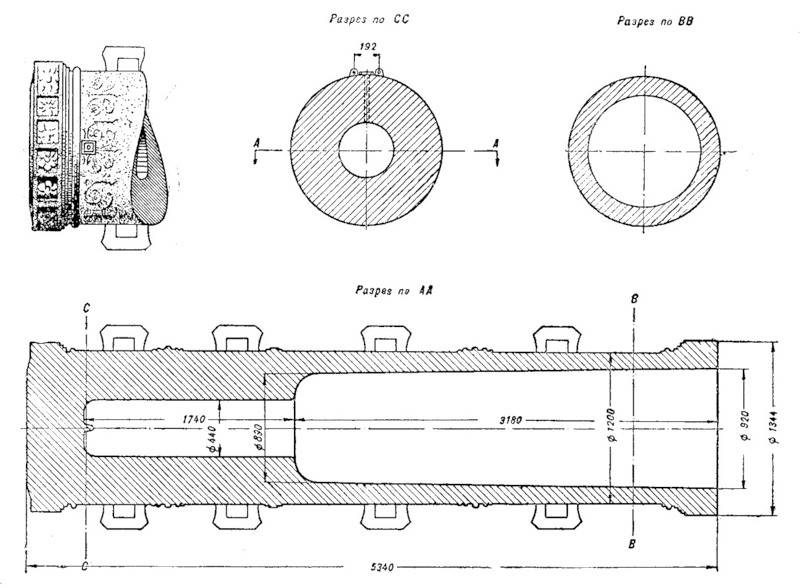
The design of the Tsar Cannon. The barrel has the characteristic features of bombards. Figure Milhist.ru
The process of loading a large-caliber bombardment was complex and lengthy, because of which she could make no more than a few shots a day. After each shot, restoration of the tip and a new loading procedure were required. With each shot, a multi-pound core caused serious damage to any fortress walls, and for several days of continuous shooting, the gunners could make a gap for the subsequent assault.
As ammunition, spherical stone cores weighing up to hundreds of kilograms were originally used. Later, mainly abroad, cast-iron kernels of a larger mass appeared. Throwing heavy ammunition was associated with increased loads on the barrel and led to its rapid wear. As the resource is depleted, bombards are often converted into shotguns - for firing stone shots. Then the weapons were written off and remelted.
The special power of the Middle Ages
One of the reasons for the appearance and development of artillery, which led to the emergence of the “classic” bombardment, was the improvement of fortification. Large-caliber guns could slowly but surely destroy any fortresses. They were a very complex, but effective tool for solving special problems.
Bombards appeared abroad, but the Russian army did not stand aside. In the XIV-XV centuries. our troops received all the necessary artillery samples, including large and special power. Such weapons were used in numerous battles and showed themselves well - despite the low operational characteristics.
However, the development of military affairs continued, and already in the XVII century. the bombard has lost its potential. Now, other weapons and equipment were required to storm the fortresses, and almost all of the outdated Russian bombards went for processing. After themselves, they left mostly only the most general descriptions and a noticeable mark in Russian military history.
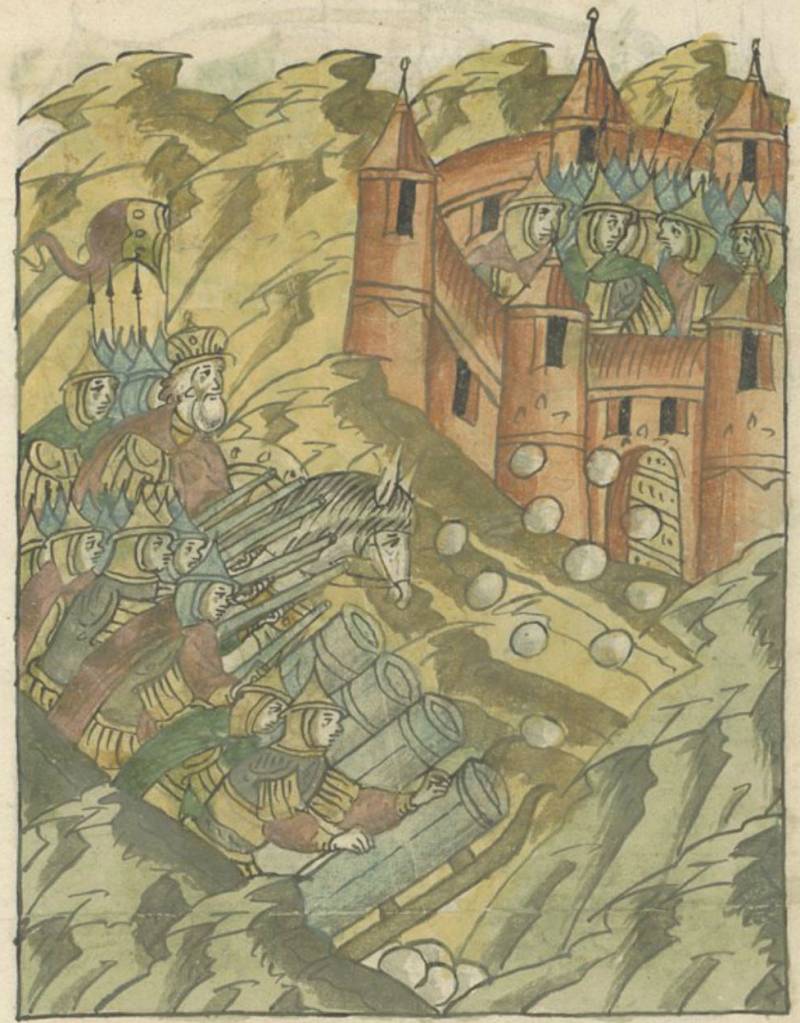
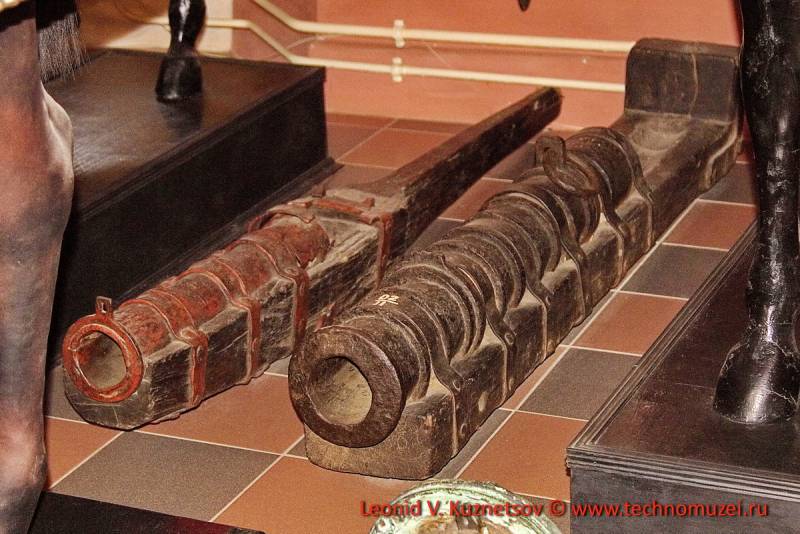
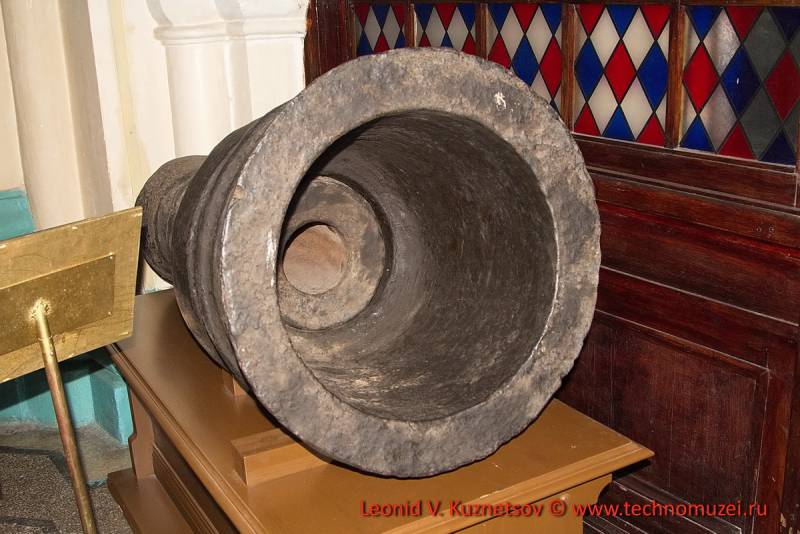
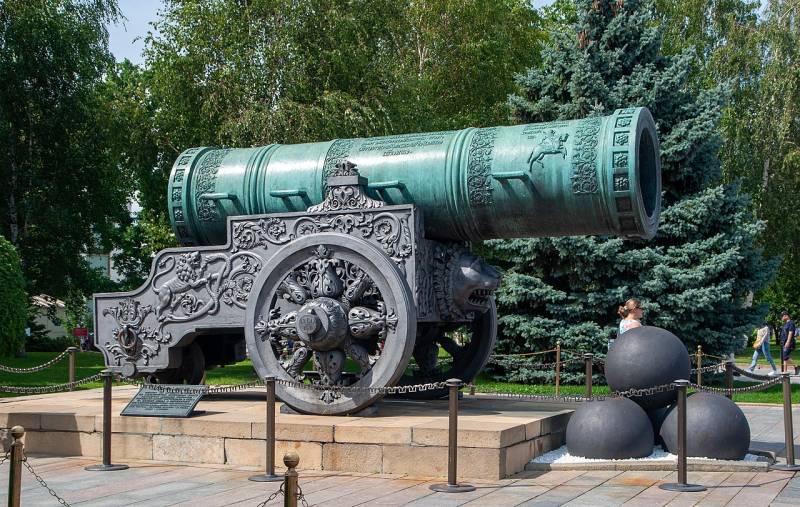
Information